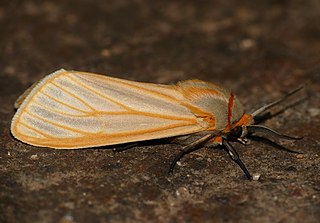Apisa is a genus of moths in the family Erebidae.

Olapa is a genus of moths in the family Erebidae. The genus was erected by Francis Walker in 1855.
Amerila bubo is a moth of the subfamily Arctiinae. It was described by Francis Walker in 1855. It is found in Angola, the Democratic Republic of the Congo, Ethiopia, Kenya, Malawi, Namibia, Rwanda, South Africa, Tanzania, Uganda, Zambia and Zimbabwe.

Amerila rufifemur is a moth of the subfamily Arctiinae. It was described by Francis Walker in 1855. It is found in Angola and the Democratic Republic of the Congo.
Marbla divisa is a moth of the family Erebidae first described by Francis Walker in 1855. It is found in subtropical Africa and is known from the Democratic Republic of the Congo, Nigeria, Madagascar, Gabon, Sierra Leone, Equatorial Guinea and Zambia.
Apisa alberici is a moth of the family Erebidae. It was described by Abel Dufrane in 1945. It is found in the Democratic Republic of the Congo.
Apisa fontainei is a moth of the family Erebidae. It was described by Sergius G. Kiriakoff in 1959. It is found in the Democratic Republic of the Congo, Kenya and Rwanda.
Apisa grisescens is a moth of the family Erebidae. It was described by Abel Dufrane in 1945. It is found in the Democratic Republic of the Congo, Malawi, Mozambique and Zimbabwe.
Apisa subargentea is a moth of the family Erebidae. It was described by James John Joicey and George Talbot in 1921. It is found in Burundi, the Democratic Republic of the Congo, Kenya and Rwanda.
Latoia is a genus of moths in the family Limacodidae. It was described by Félix Édouard Guérin-Méneville in 1844.
Creatonotos punctivitta is a moth of the family Erebidae. It was described by Francis Walker in 1855. It is found in the Democratic Republic of the Congo, Nigeria, South Africa, Sudan, Tanzania and Zambia.

Spilosoma curvilinea is a species of moth of the family Erebidae. It was described by Francis Walker in 1855. It is found in Cameroon, Republic of the Congo, Democratic Republic of the Congo, Ghana, Ivory Coast, Kenya, Nigeria, Senegal, Sierra Leone, Sudan, Tanzania, the Gambia and Uganda.
Estigmene trivitta is a moth of the family Erebidae. It was described by Francis Walker in 1855. It is found in Angola, the Democratic Republic of the Congo, Kenya, Malawi, South Africa, Tanzania and Zambia.
Eyralpenus testacea is a moth of the family Erebidae. It was described by Francis Walker in 1855. It is found in the Democratic Republic of the Congo and South Africa.
Metarctia rufescens is a moth of the subfamily Arctiinae. It was described by Francis Walker in 1855. It is found in Burundi, the Republic of the Congo, the Democratic Republic of the Congo, Gabon, Kenya, Mozambique, Rwanda, South Africa, Tanzania and Zambia.

Afromurzinia lutescens is a moth in the family Erebidae. It was described by Francis Walker in 1855. It is found in Angola, Cameroon, the Democratic Republic of the Congo, Equatorial Guinea, Ethiopia, Ghana, Guinea, Guinea-Bissau, Kenya, Nigeria, Sierra Leone, Somalia, South Africa, Tanzania, Togo, Uganda and Zimbabwe.
Gracilanja is a monotypic moth genus in the family Eupterotidae erected by Thierry Bouyer in 2011. Its single species, Gracilanja gracilis, was described by Francis Walker in 1855. It is found in Cameroon, the Republic of the Congo, the Democratic Republic of the Congo, Equatorial Guinea, Ghana, Sierra Leone and Uganda.



